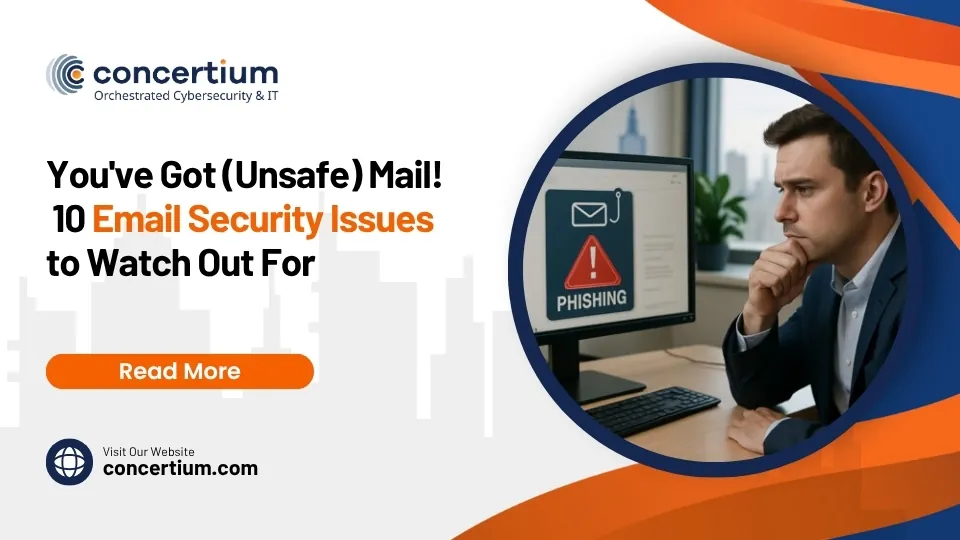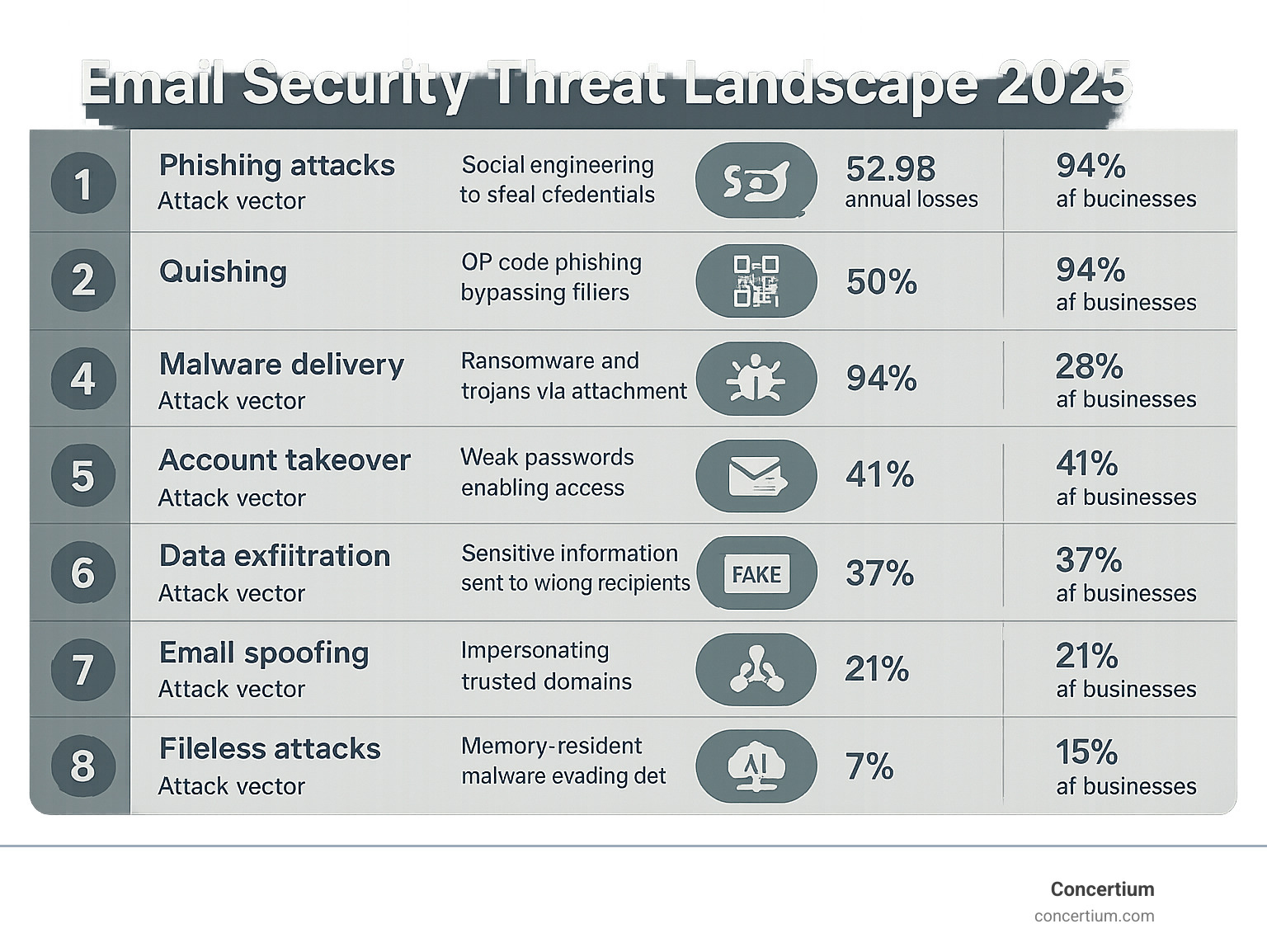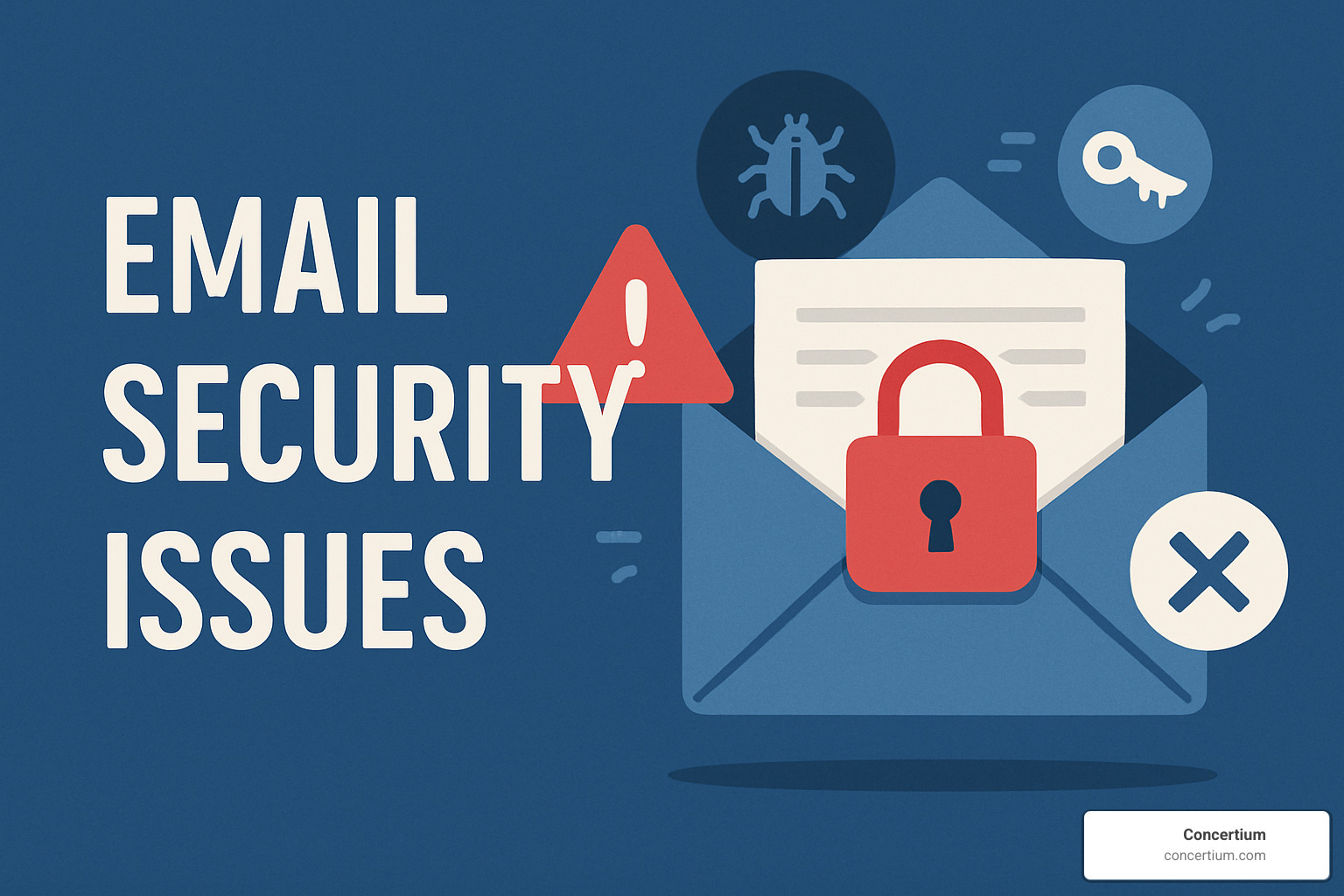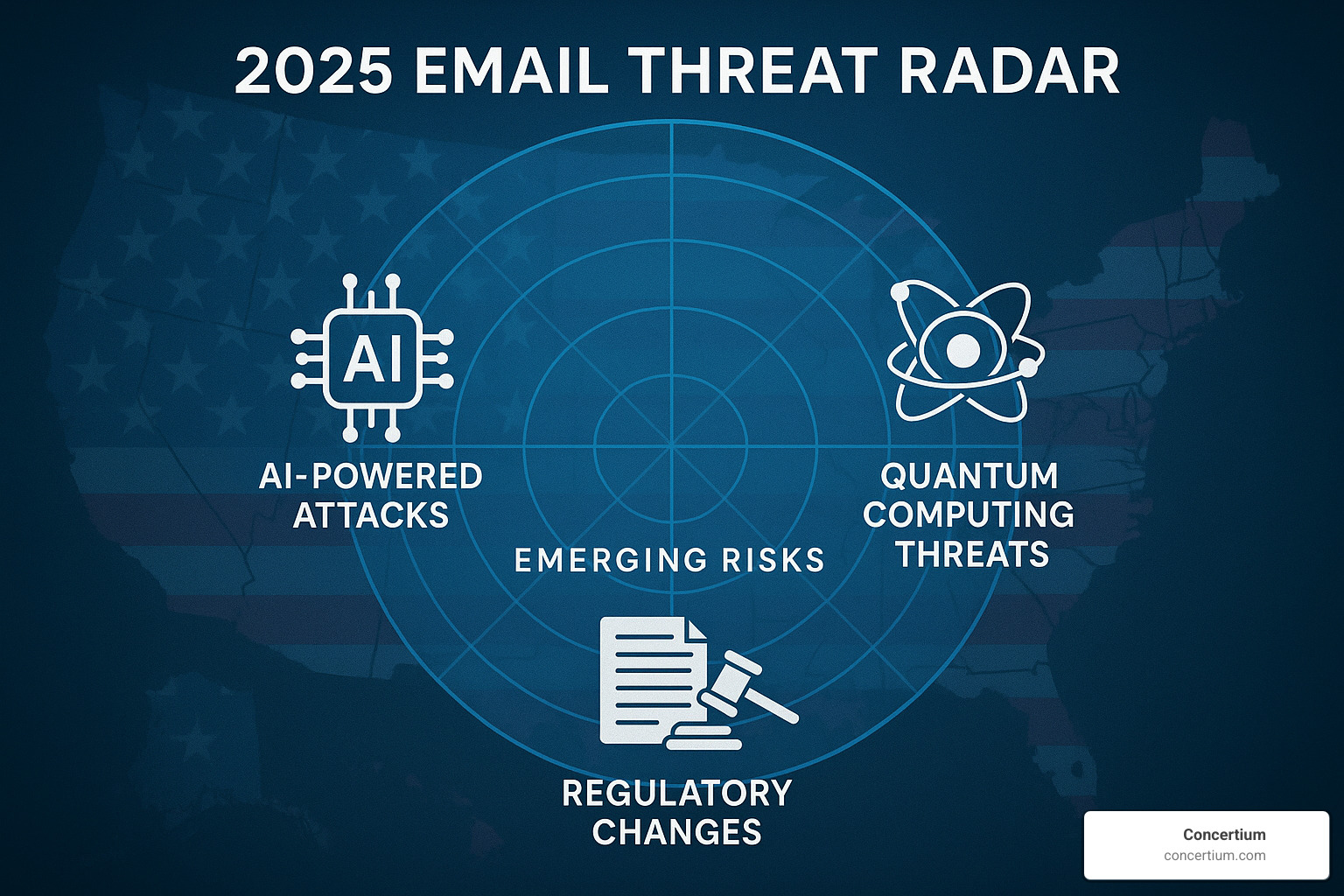Email security issues have become the number one threat vector for cyberattacks, with 94% of malware delivered through email and 91% of all cyberattacks beginning with phishing emails. As businesses increasingly rely on email for critical communications, the attack surface continues to expand.
Here are the most critical email security issues facing businesses today:
- Phishing attacks – Social engineering to steal credentials
- Business Email Compromise (BEC) – $2.9 billion in annual losses
- Quishing – QR code phishing bypassing traditional filters
- Malware delivery – Ransomware and trojans via attachments
- Account takeover – Weak passwords enabling unauthorized access
- Data exfiltration – Sensitive information sent to wrong recipients
- Email spoofing – Impersonating trusted domains
- Fileless attacks – Memory-resident malware evading detection
- AI-powered threats – Machine-generated convincing phishing
- Cloud misconfigurations – Insecure email platform settings
The problem is getting worse. Email continues to be the primary communication tool for businesses while serving as hackers’ favorite entry point. With over 350 billion emails sent daily, the volume creates countless opportunities for attackers.
88% of data breaches start as employee mistakes, and the average employee receives over 120 emails per day. This creates a perfect storm where human error meets sophisticated cyber threats.
The financial impact is devastating. Beyond the $2.9 billion lost to BEC scams alone, organizations face an average of $17,700 in losses per minute during a security breach.
Easy email security issues glossary:
Top 10 Email Security Issues in 2024
The world of email security issues has transformed dramatically this year. Cybercriminals are using artificial intelligence to craft better attacks and finding new ways to slip past our defenses. They’re targeting mobile devices, exploiting cloud misconfigurations, and getting increasingly sophisticated.
After analyzing the latest threat intelligence, we’ve identified the ten most dangerous email threats that businesses face right now. These aren’t theoretical risks – they’re actively costing organizations billions of dollars.
Phishing – The Gateway to Email Security Issues
Phishing remains the king of cyberattacks. 91% of cyberattacks begin with phishing emails, and these attacks have become incredibly sophisticated. Gone are the days of obvious spelling mistakes. Today’s phishers use AI to study how your CEO writes emails, then craft messages that sound exactly like them.
The psychology behind phishing is brilliantly simple. Attackers know exactly which buttons to push – urgency, fear, curiosity, even helpfulness. That email claiming your account will be suspended unless you act right now? It’s designed to make you panic and click before you think.
Here’s the sobering reality: 97% of people cannot reliably identify a well-crafted phishing email. Modern phishers use legitimate templates, perfect grammar, and personal details scraped from social media profiles.
Spear Phishing & Whaling
While regular phishing is like fishing with a net, spear phishing is hunting with a rifle. These attacks target specific people with carefully crafted, personalized messages. When attackers go after executives, we call it whaling.
Cybercriminals spend hours studying their targets on LinkedIn, company websites, and social media. They’ll know about your recent projects, colleagues’ names, and when you’re traveling for business.
Picture this: You’re a CFO, and you get an email from your CEO’s assistant asking for an urgent wire transfer while the boss is at a conference. The attacker knows the CEO is traveling and references a recent deal. It feels completely legitimate – until you realize you’ve just sent $50,000 to a criminal’s account.
Business Email Compromise (BEC)
BEC attacks are the crown jewel of email fraud. These scams cost organizations $2.9 billion in 2023 alone. What makes BEC so devastating is that it doesn’t need fancy malware – it just needs to trick one person into trusting the wrong email.
The most common scenarios are invoice fraud, where attackers impersonate vendors and redirect payments, CEO fraud, where criminals pose as executives requesting urgent transfers, and account compromise, where attackers gain access to real email accounts.
What’s particularly insidious about BEC is how it exploits our business relationships. When an email appears to come from a trusted vendor or your CEO, your natural instinct is to help, not question it.
Quishing (QR Code Phishing)
Quishing – phishing attacks using QR codes – is catching everyone off guard. It’s working because most email security systems treat QR codes as harmless images.
The attack is simple. Criminals embed malicious QR codes in legitimate-looking emails – fake shipping notifications, restaurant promotions, event invitations. When you scan the code, you’re taken to a phishing site or your device downloads malware.
This is particularly dangerous because we’ve trained ourselves to trust QR codes. We scan them without thinking, and that automatic behavior is exactly what attackers count on.
Malware & Ransomware Dropper Campaigns
Email remains the highway for malware delivery, with 94% of malware still arriving via email. Modern attackers use macro-enabled documents that look like legitimate business files, password-protected archives that slip past email scanners, and multi-stage payloads that download additional components after initial infection.
Ransomware delivered through email has become the stuff of nightmares. These attacks spread across entire networks, encrypting everything they find. Companies face ransom demands in the millions, and even if they pay, there’s no guarantee they’ll get their data back.
Fileless & Living-off-the-Land Attacks
Fileless attacks don’t drop malicious files on your computer. Instead, they operate entirely in memory or abuse legitimate system tools like PowerShell and Windows Management Instrumentation.
Why is this effective? Traditional antivirus software looks for malicious files, and these attacks don’t create any. They use tools that system administrators use daily for legitimate purposes, so security software typically allows them to run.
These attacks leave minimal forensic evidence and can persist through system reboots by making small registry changes rather than installing traditional malware.
Data Loss & Exfiltration
Sometimes the biggest email security issues aren’t sophisticated attacks – they’re simple human mistakes. 37% of data breaches happen because employees accidentally send sensitive information to the wrong person.
We see misdirected emails containing customer data, reply-all disasters that expose confidential information to dozens of unintended recipients, attachment errors where sensitive files go to external parties, and compromised accounts being used to steal proprietary information.
The challenge is that email is essential for business communication. We need to share sensitive information to get work done, but every email carries potential risk.
Weak Passwords & Account Takeover
Despite years of security training, weak passwords remain one of our biggest vulnerabilities. People still use passwords based on personal information – pet names, birthdays, favorite sports teams – making them easy targets for credential stuffing and brute force attacks.
Modern password-cracking tools can break common patterns in minutes. The better approach is using long, random passphrases – the famous “CorrectHorseBatteryStaple” method – combined with multi-factor authentication.
When attackers gain access to email accounts, they can monitor communications to plan future attacks, use compromised accounts to launch BEC scams, intercept password reset emails for other systems, and steal years of sensitive information. The average cost of account takeover incidents has reached $4.45 million per breach.
Authentication & Spoofing Gaps
Email authentication protocols like SPF, DKIM, and DMARC exist to prevent spoofing, but many organizations either don’t implement them or configure them incorrectly.
SPF validates sending IP addresses but can’t protect against compromised accounts. DKIM cryptographically signs messages but can be bypassed with subdomain attacks. DMARC provides policy enforcement but requires strict alignment settings for full protection.
Attackers also register look-alike domains that are visually similar to legitimate ones. They might use “arnazon.com” instead of “amazon.com” or “microsoft.co” instead of “microsoft.com”. These subtle differences are easily missed, especially on mobile devices.
Cloud Email Misconfigurations
As more organizations move to cloud email platforms like Office 365 and Google Workspace, misconfigurations have become a major security risk. The shared responsibility model means cloud providers secure the infrastructure, but customers must configure security settings properly.
Common problems include overly permissive OAuth applications that grant excessive access to email data, weak conditional access policies, insufficient monitoring of administrative activities, and default security settings that prioritize convenience over security.
Microsoft has identified specific vulnerabilities where attackers can manipulate email attributes to impersonate other users and gain unauthorized system access. These aren’t theoretical risks – they’re being actively exploited in the wild.
How Attackers Exploit Humans and Machines
Modern cybercriminals have mastered the art of playing both sides of the security equation. They’re targeting your technology and your people – and they’ve gotten pretty good at it.
The game changed when AI-powered social engineering entered the picture. We’ve seen a 135% rise in novel social engineering attacks since ChatGPT became mainstream. Attackers can now generate hundreds of personalized, convincing emails in minutes. These aren’t poorly written scam emails – they’re crafted with perfect grammar, industry-specific terminology, and writing styles that match real executives.
What makes these attacks dangerous is how they tap into basic human psychology. Attackers create urgency by claiming your account will be suspended in 24 hours. They leverage authority by impersonating your CEO or IT director. They exploit fear by warning about security breaches requiring immediate action.
The curiosity factor is particularly effective. Who hasn’t been tempted to click on an email promising “exclusive information”? Attackers also use social proof, claiming that colleagues have already taken the requested action.
Mobile devices have become the new favorite target for these email security issues. The smaller screen makes us less cautious. We’re often checking emails while distracted – waiting in line, walking between meetings, or multitasking at home.
Mobile vectors create unique vulnerabilities. The smaller screen makes it harder to spot suspicious sender addresses or scrutinize URLs carefully. We tend to act faster on mobile devices, often without the careful consideration we might give to emails on desktop computers.
QR codes have opened up entirely new attack possibilities. These seemingly innocent squares bypass traditional email filters because security systems see them as harmless images. But scan one with your phone, and you could be redirected to a credential-stealing website or automatically download malware.
Mobile security controls aren’t as comprehensive as desktop solutions either. This creates a perfect storm where reduced security meets increased vulnerability to psychological manipulation.
Deepfakes are starting to appear in email attacks too. While still relatively rare, we’re seeing audio and video content that’s increasingly difficult to distinguish from the real thing. Imagine receiving a voicemail attachment that sounds exactly like your CEO requesting an urgent wire transfer.
Behavioral evasion techniques are getting more sophisticated. Attackers study how security systems work and adapt accordingly. They might send seemingly innocent emails that establish trust before following up with malicious requests. They time their attacks to coincide with busy periods when people are more likely to act quickly.
The combination of AI-generated content and mobile delivery creates particularly dangerous scenarios. An attacker can generate dozens of personalized phishing emails targeting specific employees, then deliver them through QR codes optimized for mobile devices.
What’s concerning is how these attacks are becoming more automated and scalable. Attackers can feed AI systems information about your company and employees, then generate targeted campaigns at scale. The human element that once limited these attacks has been largely removed.
Fixing These Email Security Issues: Best Practices & Technologies
When it comes to tackling email security issues, there’s no magic bullet. Think of it like protecting your home – you wouldn’t rely on just a front door lock. You’d want security cameras, motion sensors, and maybe even a guard dog. Email security works the same way.
The foundation of modern email protection starts with Zero Trust Architecture. This approach says “trust no one, verify everything” – even emails that look perfectly legitimate. Under Zero Trust, every email gets the full security treatment regardless of who appears to be sending it.
This means verifying sender authenticity through multiple checks, scanning every attachment and link, implementing access controls that give people only the minimum permissions they need, and monitoring email activity 24/7.
Multi-Factor Authentication (MFA) is essential for protecting email accounts. Even if attackers trick someone into handing over their password, MFA creates another hurdle. However, cybercriminals are getting craftier at bypassing MFA, so organizations need to stay ahead.
Hardware security keys work best for high-value accounts like executives and IT administrators. Risk-based authentication looks at context like location and device to determine if additional verification is needed.
Modern email security solutions have evolved far beyond basic spam filters. Today’s options include Secure Email Gateways that provide traditional perimeter defense with advanced threat detection, Integrated Cloud Email Security that works natively with cloud platforms through API-based protection, and Email Data Protection solutions that focus on preventing sensitive information from walking out the door.
Behavioral AI represents the cutting edge of email security technology. These intelligent systems learn how people normally communicate within an organization. They might notice that the CEO’s writing style has suddenly changed or that someone is making unusual payment requests.
| Protocol | Purpose | Key Benefit |
|---|---|---|
| SPF | Validates authorized sending servers | Prevents basic domain impersonation |
| DKIM | Cryptographically signs messages | Ensures message integrity and authenticity |
| DMARC | Enforces SPF and DKIM policies | Provides reporting and strict authentication |
Extended Detection and Response (XDR) platforms take email security integration to the next level. Instead of treating email as an isolated system, XDR connects email threats with what’s happening across networks, endpoints, and cloud environments.
But all the fancy technology won’t help if your employees keep clicking on suspicious links. Security awareness training needs to be an ongoing conversation, not a once-a-year PowerPoint presentation.
Effective training happens continuously through bite-sized lessons that people can actually remember. It should be relevant to current threats and specific to your industry. Interactive elements like simulated phishing exercises help people practice spotting threats in a safe environment.
Email encryption protects sensitive communications, but it needs to be implemented thoughtfully. End-to-end encryption ensures only intended recipients can read messages, but it can also interfere with security scanning. Organizations need to find the right balance.
Data Loss Prevention (DLP) tools help prevent accidental and intentional data exposure through email. These systems can detect when someone tries to send sensitive information like credit card numbers, social security numbers, or proprietary documents to unauthorized recipients.
The most effective approach combines all these elements into a cohesive defense strategy. It’s not about having the most expensive tools – it’s about having the right combination of technology, processes, and people working together.
Cybercriminals are constantly adapting their tactics. Your email security strategy needs to evolve just as quickly to stay ahead of emerging threats.
Future Challenges & Emerging Trends for Email Security Issues
Looking ahead, email security issues are about to get more complicated. We’re standing at the edge of what feels like a science fiction movie, where artificial intelligence battles artificial intelligence.
The generative AI arms race is already reshaping how attackers operate. Right now, they’re using AI to write convincing phishing emails that sound just like your boss. But that’s just the beginning. Soon, we’ll see deepfake audio and video embedded right in email communications. Imagine receiving a video message that looks and sounds exactly like your CEO asking for an urgent wire transfer.
Even more concerning is the development of autonomous malware that thinks for itself. These smart threats will study your environment, adapt their behavior, and make decisions about how to spread and what to steal.
Quantum computing might sound like distant future technology, but it’s closer than you think. When practical quantum computers arrive, they’ll be able to crack the encryption we rely on today. While we’re probably still a decade away from this reality, smart organizations are already planning for quantum-resistant crypto.
The shift to cloud-first email strategies is driving another major change: API-based protection. Traditional security tools that sit at the network perimeter become less effective when your email lives entirely in the cloud. The new generation of security solutions plugs directly into your email platform through APIs.
Regulatory shifts are adding another layer of complexity. Privacy laws like GDPR were just the beginning. We’re seeing new regulations that focus specifically on AI transparency in security systems, stricter rules about moving data across borders, and faster breach notification requirements.
The mobile revolution continues to accelerate, and attackers are paying attention. More people read email on their phones than on computers now, and mobile security tools haven’t kept pace. We’re also seeing attacks that target IoT devices with email capabilities – everything from smart printers to connected appliances.
What makes all of this particularly challenging is the speed of change. New email security issues emerge faster than most organizations can adapt their defenses. The traditional approach of updating security policies once a year simply won’t work.
The organizations that will thrive are those that accept continuous adaptation, invest in AI-powered defense systems, and maintain a healthy balance between security and usability. It’s not about predicting every possible threat – it’s about building systems that can evolve as quickly as the threats themselves.
FAQ: Email Security Issues, Answered
Let’s tackle the most common questions we hear about email security issues. These answers come from our nearly 30 years of experience helping organizations protect themselves from evolving cyber threats.
What makes phishing so effective today?
Phishing has gotten scary good at fooling people.
Modern attackers combine sophisticated technology with deep understanding of human psychology. They’re using AI tools to generate emails that sound exactly like your boss, complete with the right tone and even inside jokes.
The technical side is equally concerning. Phishing kits – essentially DIY crime packages – let even non-technical criminals launch convincing attacks. These kits come with templates, hosting, and even customer support.
But the real secret weapon is psychological manipulation. Attackers rely on emotional triggers that have worked for decades: urgency, authority, fear, and curiosity. The difference is they now deliver these triggers through perfectly crafted messages that arrive on mobile devices where you’re more likely to act quickly without thinking.
Do SPF, DKIM, and DMARC stop all spoofing?
These protocols are incredibly important, but they’re not magic bullets. Think of them as the locks on your front door – essential, but not your only security measure.
SPF only checks if emails come from approved IP addresses. That’s great until attackers compromise a legitimate email account and send attacks from inside your trusted network. DKIM adds cryptographic signatures, but clever attackers can sometimes bypass this through subdomain attacks.
DMARC ties everything together by telling other email systems what to do when SPF or DKIM checks fail. The catch? Many organizations run DMARC in “monitor only” mode rather than actually blocking suspicious emails.
These protocols work best when implemented together with strict policies, but they should be part of your broader email security strategy.
How often should employees undergo training?
Forget the annual training session. That approach is about as effective as getting a flu shot once and expecting lifetime immunity.
The threat landscape changes constantly. New attack techniques emerge monthly, and your team needs to stay current with what’s actually happening. We recommend a continuous approach that includes monthly micro-lessons covering current threats, quarterly simulated phishing exercises with immediate feedback, and real-time alerts about emerging threats.
The most effective programs also include just-in-time training triggered when someone interacts with suspicious emails. Instead of waiting for the next training cycle, they get immediate education about what they just encountered.
88% of data breaches involve human error. Your people aren’t the weakest link – they’re your strongest defense when properly equipped with current knowledge and practical skills.
Conclusion
We’ve covered a lot of ground today, and honestly, email security issues can feel overwhelming. But here’s the thing – you’re not powerless against these threats.
Yes, the statistics are sobering. 94% of malware still comes through email, and attackers are getting smarter every day with AI-powered phishing and sophisticated social engineering. But understanding these threats is the first step toward defending against them.
The old days of simply installing an antivirus program and calling it good are long gone. Today’s email security issues require a completely different approach – one that assumes every email could be a threat and verifies everything before trusting it.
That’s where our Collective Coverage Suite (3CS) approach comes in. We’ve spent nearly 30 years watching the cybersecurity landscape evolve, and we’ve learned that cookie-cutter solutions just don’t work. Your manufacturing company faces different threats than a healthcare practice or a law firm.
Our AI-improved observability and automated threat eradication means we’re not just catching known threats – we’re identifying new attack patterns before they become widespread problems. And when something does slip through? Our rapid response capabilities help minimize the damage.
The reality is that email will always be a target because it’s how business gets done. You can’t stop using email, but you can make it much harder for attackers to succeed. This means combining smart technology with ongoing user training and having a solid incident response plan ready to go.
The best part? Prevention really is cheaper than recovery. We’ve seen too many businesses learn this lesson the hard way after a successful attack brings their operations to a grinding halt.
Don’t wait until you’re dealing with ransomware or explaining to customers why their data was compromised. The threat landscape isn’t slowing down, and neither should your defenses.
Ready to take the next step? Learn more about our cybersecurity services and let’s build a defense strategy that actually fits your business – not someone else’s template.






